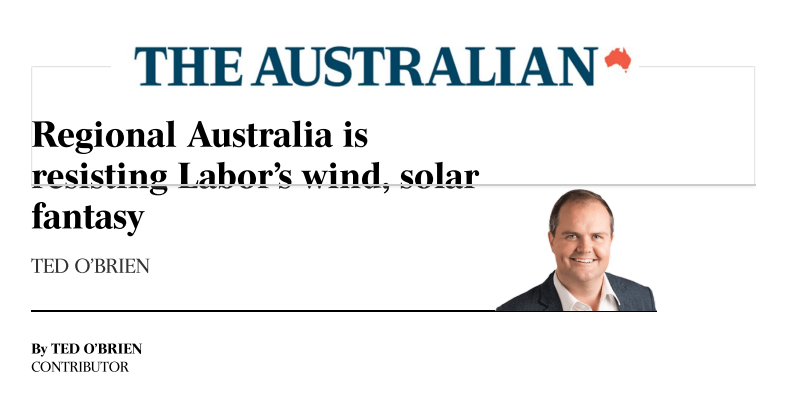As published in The Australian on 18 September 2023.
Labor’s reckless indifference towards regional communities is jeopardising its target of 82 per cent renewables in the electricity grid by 2030.
Like the obsession of a jealous lover, Labor’s infatuation with wind and solar tempts tragedy for the very panels and blades it so desperately desires, as communities that host these technologies start saying “no”.
Regional Australia understands the importance of new technology to tackle climate change, but threaten their way of life and all bets are off.
Labor’s radical experiment of an electricity grid built almost entirely on wind and solar defies economics and engineering, and the scale and speed of its proposed rollout is unprecedented: 22,000 solar panels installed every day and 40 wind turbines every month until 2030, along with tens of thousands of kilometres of transmission lines.
To Labor’s alarm, its plan isn’t working. Renewables are being rolled out at half the pace envisaged and private sector investment has stalled: not one new renewable generation project reached final investment decision in the first two quarters of this year.
In desperation, Energy Minister Chris Bowen is responding like a bullyboy who lives by the mantra “all is fair in love and war”.
Those most squarely in Bowen’s way are residents of regional communities who are expected to bear the brunt of the economic, environmental and amenity compromises that Labor’s policy necessitates.
People in regional Australia typically possess higher energy-IQ than their metropolitan cousins for the simple reason that they’re accustomed to hosting power stations, big transmission lines, mining sites and big industrial plants. They’re up for action on climate change but that doesn’t mean they’re going to cop being steamrolled.
I’ve been to communities that fear wind towers nearly 300 metres high ruining tourism businesses, landscapes and ocean views. I’ve met lobster and crab farmers who have turned to political activism to protect their livelihoods from misplaced offshore wind farms.
I’ve spoken to environmentalists fearing the impact of renewable projects on natural habitats of threatened species and on loved animals like the humpback whale. I’ve visited people in their homes who will no longer overlook picturesque rolling hills but the harsh glare of solar panels at an industrial scale. I’ve met residents decrying the impost and unfair compensation for transmission lines set to carpet their own properties.
I’ve spoken to farmers and local councils worried that prime agricultural land and farming will be lost from their area forever. I’ve heard complaints about toxic discarded batteries, solar panels and wind turbine blades, with no waste management solution beyond landfill.
I’ve met residents kept in the dark about offshore wind zones as unions co-opt the consultation process with flyers on “how to make a supportive submission”.
Building a social license for any infrastructure project can be difficult at the best of times, but this is anything but the best of times: people are fatigued, cost of living is biting, mortgage payments are soaring and workers are worried about the future for their industries.
Public consultations for renewable projects gives the Albanese government the fig leaf of a democratic process, but, in reality, they’re seen as little more than tick and flick exercises.
Hopes that this might all change arose recently, only to be quickly snuffed out.
In July, Bowen announced a “Community Engagement Review” to improve community engagement on renewable energy projects.
I was on the NSW central coast at the time, hearing concerns from residents about consultations for the Hunter offshore wind zone.
The minister’s announcement was welcomed as a concession, tantamount to an admission, that the consultation process was flawed. Finally, Labor was going to put residents and communities ahead of investors and developers, or so it seemed.
But, to the bewilderment of many, the minister proceeded to declare the Hunter offshore wind zone the following week. What’s more, using the same flawed process, the Minister opened consultation for two more zones, in the Illawarra and Southern regions, and is soon open yet another two in Western Australia.
Is it any wonder that regional communities are raging?
The problem is that Labor is hell bent on a renewables-only future, at any cost.
Ironically enough, it’s this very approach that will limit the rollout of transmission lines, wind and solar across regional Australia.
Unless Labor changes course, the social license of renewables in regional areas will continue to deteriorate and its 82 per cent renewables target will be destined for the scrap heap of history.
The alternative is an “all-of-the-above” approach with every option on the table, including renewables which have an important role to play as part of a balanced energy mix.
To Labor, this may feel like a form of polygamy. But in the world of economics and engineering, unlike matters of the heart, it’s variety that counts. Just ask regional Australia.
Download the full article HERE.
